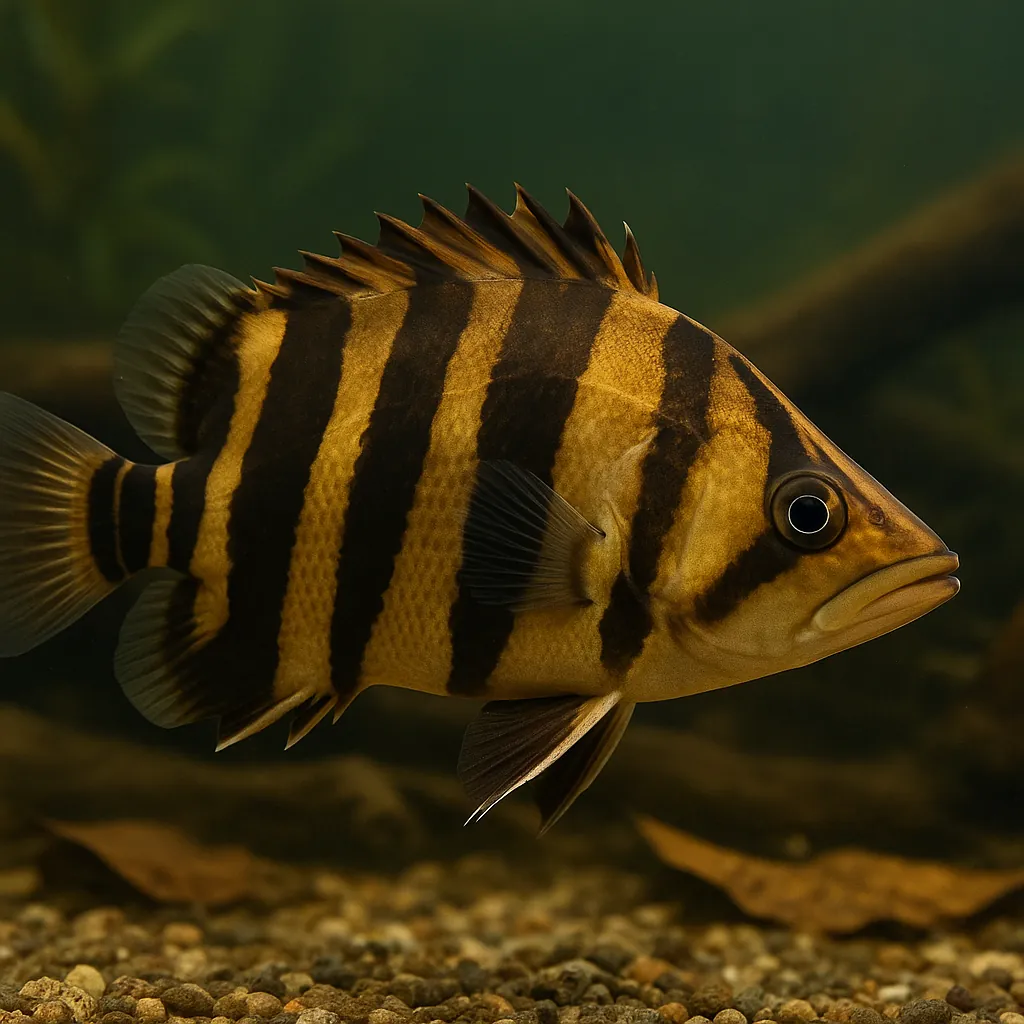
Siamese tiger datnoid
Introduction
The Siamese tiger datnoid, also known as the Siamese tigerfish or gold datnoid, is a striking freshwater species cherished by aquarists for its bold black vertical stripes against a golden-yellow body. This predatory fish can grow up to 30 cm (12 inches) in captivity and requires specific care to thrive. While its captivating appearance makes it a desirable addition to large aquariums, the Siamese tiger datnoid demands attention to detail in its care, making it more suitable for intermediate to advanced fishkeepers.
What makes the Siamese tiger datnoid appealing to aquarists?
Its vibrant coloration and distinctive patterning, combined with its dynamic behavior, make it a standout species in large freshwater aquariums.
Is the Siamese tiger datnoid suitable for beginner fishkeepers?
Due to its size, dietary needs, and specific environmental requirements, it is better suited for intermediate to advanced aquarists.
Care and Environment
Proper care for the Siamese tiger datnoid involves attention to tank size, water parameters, diet, and tank setup to replicate its natural habitat.
What is the minimum tank size for a Siamese tiger datnoid?
A minimum of 400 liters is recommended for a single fish to provide adequate space for swimming and growth.
What are the ideal water parameters for this species?
Maintain a temperature between 24-28°C, pH levels of 6.5-7.5, and water hardness of 5-15 dGH to ensure optimal health.
Filtration should be robust to handle the significant waste produced by this species. A high-quality canister filter is advisable to maintain water clarity and quality. Moderate water flow is preferred, mimicking their natural riverine environments.
Lighting should be subdued, as bright lights can cause stress. Incorporate hiding spots using driftwood, rocks, and sturdy plants to provide shelter and reduce stress.
The Siamese tiger datnoid is a carnivorous predator. Offer a varied diet of live or frozen foods such as shrimp, small fish, and worms. High-quality carnivore pellets can also be included to ensure a balanced diet. Feed once or twice daily, avoiding overfeeding to maintain water quality.
Are there any specific challenges in keeping Siamese tiger datnoids?
They can be shy, especially when young, and may require time to acclimate. Additionally, they are sensitive to poor water conditions, necessitating regular maintenance and monitoring.
Origin and Habitat
Native to Southeast Asia, the Siamese tiger datnoid inhabits the Mekong and Chao Phraya river basins, as well as regions in Indonesia and western Borneo. They are typically found in large rivers, tributaries, and connected lakes, favoring areas with submerged wood and rocky crevices. These environments often have moderate water flow and are rich in vegetation, providing ample hiding spots and hunting grounds.
What type of environment does the Siamese tiger datnoid prefer?
They thrive in freshwater rivers and lakes with moderate flow, abundant submerged structures, and ample hiding spots.
How does their natural habitat influence their care in captivity?
Replicating their natural environment with appropriate tank decor, water flow, and hiding spots is crucial for their well-being in captivity.
Temperament and Compatibility
The Siamese tiger datnoid is generally peaceful but can exhibit territorial behavior, especially towards its own kind. They are best kept singly or in groups of five or more to disperse aggression. Suitable tank mates include larger, non-aggressive species such as bichirs, arowanas, and large catfish. Avoid housing them with smaller fish, as they may be viewed as prey.
Can Siamese tiger datnoids be kept with other fish?
Yes, but choose tank mates carefully. Larger, peaceful species are ideal, while smaller fish should be avoided to prevent predation.
Do they require being kept in groups?
They can be kept singly or in groups of five or more. Smaller groups may lead to aggression among individuals.
Interesting Facts
The Siamese tiger datnoid has the ability to change its coloration, often darkening when stressed or during hunting. This camouflage aids in ambushing prey. In the wild, they are known to assume unusual positions, such as hanging upside down, to blend with their surroundings. Despite their predatory nature, they lack teeth and rely on suction to capture prey.
Can Siamese tiger datnoids change color?
Yes, they can adjust their coloration, often darkening to blend with their environment or when stressed.
How do they capture their prey without teeth?
They use a powerful suction mechanism to draw prey into their mouths, compensating for the lack of teeth.
Sources
All information in this article has been gathered from the following reputable sources:
Overview
Recommended Tank Size 158.5 Gallons (for groups of 5 or more) |
Minimum Group Size 1 |
Minimum Tank Volume 105.7 Gallons |
Maximum Adult Length 11.8 inches |
Average Adult Length 9.8 inches |
Shoaling (6+ required) No |
Preferred Water Type Freshwater, slightly acidic to neutral |
Temperature Range (°C) 24-28 |
pH Range 6.5-7.5 |
Water Hardness (dGH) 5-15 |
Typical Lifespan (years) 10 years |